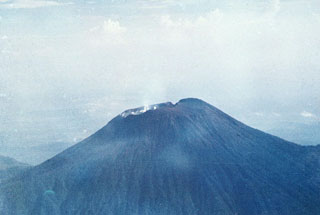Report on Slamet (Indonesia) — November 1989
Scientific Event Alert Network Bulletin, vol. 14, no. 11 (November 1989)
Managing Editor: Lindsay McClelland.
Slamet (Indonesia) Increased seismicity and gas emission
Please cite this report as:
Global Volcanism Program, 1989. Report on Slamet (Indonesia) (McClelland, L., ed.). Scientific Event Alert Network Bulletin, 14:11. Smithsonian Institution. https://doi.org/10.5479/si.GVP.SEAN198911-263180
Slamet
Indonesia
7.242°S, 109.208°E; summit elev. 3428 m
All times are local (unless otherwise noted)
Increased seismicity (table 1) and gas emission have been observed at Slamet since the second week in October. A white plume rose as much as 300 m, compared to 100-150 m the previous week. Geologists noted that a small eruption could occur at any time. The alert level has been increased and local officials have been notified. Slamet's most recent activity was a weak 30-hour Strombolian eruption 12-13 July [1988], preceded by tremor that began at 1145. No casualties were reported.
Table 1. Seismicity recorded at Slamet, 7-10 October 1989. S-P of A-type events is 1.5-4 seconds. Courtesy of VSI.
| Seismicity | A-type | B-type | Degassing |
| 07 Oct 1989 | -- | 1 | 11 |
| 08 Oct 1989 | -- | -- | 30 |
| 09 Oct 1989 | 25 | 18 | 200 |
| 10 Oct 1989 | 200 | 10 | 11 |
Geological Summary. Slamet is one of Java's most active volcanoes. It has a cluster of about three dozen cinder cones on its lower SE-NE flanks and a single cinder cone on the W flank. It is composed of two overlapping edifices, an older basaltic andesite to andesitic volcano on the west and a younger basaltic to basaltic andesite one on the east. Gunung Malang II cinder cone on the upper E flank on the younger edifice fed a lava flow that extends 6 km E. Four craters occur at the summit of Gunung Slamet, with activity migrating to the SW over time. Eruptions recorded since the 18th century have originated from a 150-m-deep, 450-m-wide, steep-walled crater at the western part of the summit and have consisted of explosive eruptions generally lasting a few days to a few weeks.
Information Contacts: VSI.

